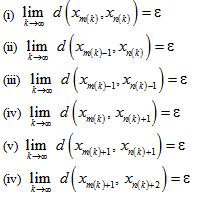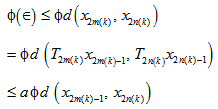-
Paper Information
- Next Paper
- Previous Paper
- Paper Submission
-
Journal Information
- About This Journal
- Editorial Board
- Current Issue
- Archive
- Author Guidelines
- Contact Us
American Journal of Mathematics and Statistics
p-ISSN: 2162-948X e-ISSN: 2162-8475
2013; 3(4): 190-193
doi:10.5923/j.ajms.20130304.02
Common Fixed Point Theorem by Subadditive Altering Distance Function for Sequence of Mappings
1Department of Mathematics and Computer Science, Rani Durgawati University., Jabalpur, M.P., India
2Department of Mathematics and Computer Science, Govt. Model Science College, Jabalpur, M.P., India
Correspondence to: P. L. Powar, Department of Mathematics and Computer Science, Rani Durgawati University., Jabalpur, M.P., India.
| Email: |  |
Copyright © 2012 Scientific & Academic Publishing. All Rights Reserved.
In the present paper, the authors have noticed that the condition, which has been imposed to compute the unique common fixed point for sequence of mappings used by Iseki[6] in 1974 and Babu G.V.R. et al.[2], can be replaced by another generalized condition, which significantly reduce large number of computational steps and established the same result. In addition, the generalized condition introduced in this paper includes several results on fixed point theory by considering special values of parameter. (see cf.[2],[21]).
Keywords: Common Fixed Point, Complete Metric Space, Subadditive Altering Distance Function
Cite this paper: P. L. Powar, G. R. K. Sahu, Common Fixed Point Theorem by Subadditive Altering Distance Function for Sequence of Mappings, American Journal of Mathematics and Statistics, Vol. 3 No. 4, 2013, pp. 190-193. doi: 10.5923/j.ajms.20130304.02.
Article Outline
1. Introduction
- The Banach contraction principle is one of the most important results in the metric fixed point theory. Theorems related to existence and uniqueness of fixed points are known as fixed point theorems. The theory of fixed points has become an important tool in non linear functional analysis since 1930. The significance of this field lies in its vast applicability to many branches of mathematics and other sciences. The study of common fixed points of mappings satisfying different contractive conditions has been explored extensively by many mathematicians ([1],[3],[5] &[6]). Recently, the fixed point theorem involving the concept of altering distance functions has become more popular and widely used by many researchers ([7] -[21]).Iseki[6], Babu, G.R.V. et al.[2] had established an interesting result on unique common fixed point for sequence of mappings by using altering distances. It has been noticed that the right hand side of the condition for altering distances involved many complex functions of the metric d. Moreover, while showing the sequence obtained by iterations is Cauchy, these functions are very much difficult to handle from computation point of view.It may be interesting to know that only one simple function involving the metric d is enough to establish the same assertion. In addition, the free parameter, which we have introduced in the contraction of condition, plays crucial role in covering several other results with specific different choices.This flexibility of the condition may lead to some significant simple applications of the result to differential equations.
2. Preliminaries
- In order to establish the main result, we require the following definitions and results are required:Definition 2.1 Let (X, d) be a metric space. A mapping T:
 is called a contraction mapping if there exists a real number k,
is called a contraction mapping if there exists a real number k,  , such that d (Tx, Ty)
, such that d (Tx, Ty)  kd (x, y), for all x, y in X.The well-known Banach contraction theorem is given below:“If T is a mapping of a complete metric space X into itself such that d(Tx,Ty)
kd (x, y), for all x, y in X.The well-known Banach contraction theorem is given below:“If T is a mapping of a complete metric space X into itself such that d(Tx,Ty)  k d(x,y), for all x, yX and 0 < k <1. Then T has a unique fixed point.” Definition 2.2 A function
k d(x,y), for all x, yX and 0 < k <1. Then T has a unique fixed point.” Definition 2.2 A function  is called a subadditive altering distance function if the following properties are satisfied: (i)
is called a subadditive altering distance function if the following properties are satisfied: (i)  is a continuous function (ii)
is a continuous function (ii)  is a monotonically increasing function (iii)
is a monotonically increasing function (iii)  (iv)
(iv)  Lemma 2.1 (Lemma 1.3 of[14]). Let (M, d) be a metric space. Let {xn} be a sequence in M such that
Lemma 2.1 (Lemma 1.3 of[14]). Let (M, d) be a metric space. Let {xn} be a sequence in M such that  . If {xn} is not a Cauchy sequence in M, then there exists an
. If {xn} is not a Cauchy sequence in M, then there exists an  for which, the subsequences
for which, the subsequences  and
and  of {xn} may be obtained with m(k) > n(k) > k such that
of {xn} may be obtained with m(k) > n(k) > k such that  and
and 
3. Results Already Proved
- In 1974, Iseki (cf.[6]) established the following result: Theorem 3.1 (Theorem 4.3 of[11]). Let (X, d) be a complete metric space and
 be a sequence of self maps of X. Suppose there are non-negative real numbers
be a sequence of self maps of X. Suppose there are non-negative real numbers  such that for any x, y in X and i, j = 1, 2,…, n…
such that for any x, y in X and i, j = 1, 2,…, n… where
where  Then
Then  has a unique fixed point. Sastry et al.[20] have initiated the following Theorem in 1999:Theorem 3.2 (Theorem 4.2 of[11]). Let (X, d) be a bounded complete metric space. Suppose
has a unique fixed point. Sastry et al.[20] have initiated the following Theorem in 1999:Theorem 3.2 (Theorem 4.2 of[11]). Let (X, d) be a bounded complete metric space. Suppose  is a sequence of self maps of X such that TiTj = Tj Ti, for all i, j = 1, 2,…, n,…and satisfies the inequality: There exists k
is a sequence of self maps of X such that TiTj = Tj Ti, for all i, j = 1, 2,…, n,…and satisfies the inequality: There exists k (0, 1) and
(0, 1) and 
 Then, the sequence
Then, the sequence  has a unique common fixed point. Babu et al.[2] had proved the following result in 2001:Theorem 3.3 (Theorem 4.5 of[11]). Let (X, d) be a complete metric space and
has a unique common fixed point. Babu et al.[2] had proved the following result in 2001:Theorem 3.3 (Theorem 4.5 of[11]). Let (X, d) be a complete metric space and  be a sequence of self maps of X. Suppose there is a
be a sequence of self maps of X. Suppose there is a  satisfying the following inequality:There exists k
satisfying the following inequality:There exists k [0, 1) such that
[0, 1) such that  for all x, y
for all x, y X and for all j = 1, 2,…n,…. Then the mappings
X and for all j = 1, 2,…n,…. Then the mappings  have a unique common fixed point in X.
have a unique common fixed point in X. 4. Main Result
- Theorem 4.1 Let
 be a sequence of self maps on a complete metric space (X, d) and
be a sequence of self maps on a complete metric space (X, d) and  be an altering distance function satisfying the condition:
be an altering distance function satisfying the condition: | (4.1) |
 X, where 0 < a < ½ .Then
X, where 0 < a < ½ .Then  has a unique common fixed point in X. Remark 4.1 It may be noted that any specific choice of parameter ‘a’ should be bounded by 0 and ½.Proof. Let x be an arbitrary point in X and {xn} be a sequence of points of X. Consider
has a unique common fixed point in X. Remark 4.1 It may be noted that any specific choice of parameter ‘a’ should be bounded by 0 and ½.Proof. Let x be an arbitrary point in X and {xn} be a sequence of points of X. Consider  | (4.2) |
 | (4.3) |
 This implies that
This implies that  Hence
Hence  . Thus, by induction, it follows
. Thus, by induction, it follows  This implies that
This implies that  is decreasing sequence of non-negative real numbers; hence, it converges to zero,
is decreasing sequence of non-negative real numbers; hence, it converges to zero,  Since
Since 
 This implies that the sequence {
This implies that the sequence { } is also a deceasing sequence of non-negative real number and hence
} is also a deceasing sequence of non-negative real number and hence  as
as  .Claim: The sequence {xn} is a Cauchy sequence. For this, it is sufficient to show that the subsequence {x2n} of {xn} is a Cauchy sequence, Let, if possible, {x2n} is not a Cauchy sequence, then there exists an
.Claim: The sequence {xn} is a Cauchy sequence. For this, it is sufficient to show that the subsequence {x2n} of {xn} is a Cauchy sequence, Let, if possible, {x2n} is not a Cauchy sequence, then there exists an  and monotonically increasing sequence of natural numbers {2m(k)} and {2n(k)} such that n(k) > m(k) ,
and monotonically increasing sequence of natural numbers {2m(k)} and {2n(k)} such that n(k) > m(k) ,  | (4.4) |
 This implies that
This implies that  Letting
Letting  , yields
, yields (using lemma 2.1)which is a contradiction. Hence, {x2n} is a Cauchy sequence therefore {xn} is a Cauchy sequence in X. Since X is complete metric space, therefore {xn} converges to a point x
(using lemma 2.1)which is a contradiction. Hence, {x2n} is a Cauchy sequence therefore {xn} is a Cauchy sequence in X. Since X is complete metric space, therefore {xn} converges to a point x X.Claim: x is a common fixed point of sequence of mappings
X.Claim: x is a common fixed point of sequence of mappings  . Consider
. Consider  Applying limit as
Applying limit as  , we get
, we get  This implies that
This implies that  i.e. Tmx = x, for all m = 1, 2,… This show that x is fixed point of Tm,
i.e. Tmx = x, for all m = 1, 2,… This show that x is fixed point of Tm,  m = 1, 2,… Thus, x is a common fixed point of the sequence of mappings
m = 1, 2,… Thus, x is a common fixed point of the sequence of mappings  .Claim: x is unique. Let, if possible,
.Claim: x is unique. Let, if possible,  such that y is also a fixed point of Tn, for all n=1, 2,…i.e. Tny = y, for all n =1, 2, … Now
such that y is also a fixed point of Tn, for all n=1, 2,…i.e. Tny = y, for all n =1, 2, … Now 
 This implies that
This implies that  which is a contradiction. Thus, x is unique common fixed point of sequence of mappings
which is a contradiction. Thus, x is unique common fixed point of sequence of mappings  .
.5. Conclusions
- By considering d
 , the following may be noted :(i) Putting
, the following may be noted :(i) Putting  and
and  where
where  and
and  in (4.1) leads to the Theorem 4.3 of[11].(ii) Putting
in (4.1) leads to the Theorem 4.3 of[11].(ii) Putting  where 0 < k < 1 in (4.1) yields Theorem 4.2 of [11]. (iii) Putting
where 0 < k < 1 in (4.1) yields Theorem 4.2 of [11]. (iii) Putting  , where
, where 
 and 0 < k < 1 in (4.1) Theorem 4.5 of[11] can obtained.Note: (ii) and (iii) hold without sub-additive condition on
and 0 < k < 1 in (4.1) Theorem 4.5 of[11] can obtained.Note: (ii) and (iii) hold without sub-additive condition on  .
.ACKNOWLEDGEMENTS
- Authors would like to thank referees of this paper for their valuable suggestions.
 Abstract
Abstract Reference
Reference Full-Text PDF
Full-Text PDF Full-text HTML
Full-text HTML